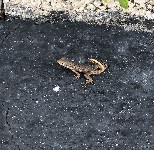Northern Curly-Tailed Lizard (Leiocephalus carinatus)
Description: Adults may attain a snout to vent length (SVL) of 4.1 inches, or a total length, including the tail, of 10 inches. The dorsal scales are keeled and pointed. L. carinatus resembles lizards of the genus Sceloporus, but with the tail usually curled upward, especially when the lizard is in a horizontal position on rocks or on the ground.
Habitat: Xerophilic; mostly coastal but also in low uplands on Cuba; among logs and debris; favors diente de perro limestone areas with sand interstices; cacti, mogotes, windrows of broken coral on beaches, sea cliffs, quarries, in and about human habitation, on driftwood, in old rock walls, beaches; juveniles sometimes found partially buried in sand under rocks. Open woods, coconut strands, beach dunes, lawns, gardens; terrestrial and arboreal.
Range: It was originally found only on Grand Bahama Island and the Abacos, but was released intentionally in Palm Beach, Florida in the 1940s. It has since spread, and now lives widely in southern Florida in addition to places in Bahamas.
Found in these States:
FL
Diet: Eats mainly invertebrates. Omnivorous; eats flowers of IPOMOEA and other plants, buds, seeds, small fruits, anoline lizards, terrestrial crustaceans, spiders, beetles, roaches, ants.
Reproduction: Lays eggs in midsummer (captives have laid in spring). Incubation 51-74 days. Major period of hatching apparently mid-July.
Status: Leiocephalus carinatus is assessed as Least Concern because of its wide distribution and tolerance of a variety of habitats, including anthropogenic environments. Further research is needed to clarify whether localized declines are taking place.
Subspecies: One in our region:
Little Bahama Curly-tailed Lizard - (Leiocephalus carinatus armouri)
»» Kingdom: Animalia - Animals
»» Phylum: Chordata - Chordates
»» Subphylum: Vertebrata - Vertebrates
»» Class: Reptilia - Reptiles
»» Order: Squamata - Lizards
»» Family: Leiocephalidae - Curly-Tailed Lizards
»» Genus: Leiocephalus
»» Species: Leiocephalus carinatus - Northern Curly-Tailed Lizard
»» Subspecies:
Leiocephalus carinatus armouri - Little Bahama Curly-tailed Lizard
This article uses material from the Wikipedia article "Leiocephalus carinatus", which is released under the Creative Commons Attribution-Share-Alike License 3.0. Content may have been omitted from the original, but no content has been changed or extended.
|








